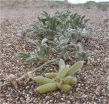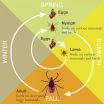Physical exercise helps women with breast cancer to better tolerate chemotherapy
2015-04-27
(Press-News.org) Women with breast cancer who follow a physical exercise program during their chemotherapy treatment experience less side effects like fatigue, reduced physical fitness, nausea and pain. It is also less often necessary to adjust the dosage of their chemotherapy. This is shown by a study supervised by prof. dr. Neil Aaronson of the Netherlands Cancer Institute (NKI).
Chemotherapy can be very burdensome for patients. Because of the side effects, not all patients are able to complete their chemotherapy as originally planned, but require a dose adjustment. There are some indications that physical exercise might help reduce these side effects. Neil Aaronson of the NKI was interested in determining which type of physical exercise programs are most effective, and whether such programs can also help patients better tolerate their chemotherapy. He investigated these issues in a group of women with breast cancer who received adjuvant chemotherapy. The research project, nicknamed PACES, was for a large part carried out by PhD student Hanna van Waart of Aaronson's research group, in close collaboration with the Physical Therapy department of the NKI. The results of the project are now published in the Journal of Clinical Oncology.
Aaronson and Van Waart randomly divided 230 breast cancer patients into three groups. The first group followed a moderately intensive aerobic and strength exercise program, under supervision of a trained physiotherapist. Women in the second group were assigned to a low intensity aerobic exercise program that they could follow at home, which was coached by a trained nurse or nurse practitioner. The third group did not follow any exercise program. The results of the study were clear. Both groups of women who followed an exercise program experienced less fatigue, loss of fitness, nausea and pain during their chemotherapy treatment. This effect was most pronounced in the group of women who followed the supervised, moderately intensive program. The women in this group were also the ones who endured their chemotherapy best; only twelve percent of them required a dose adjustment. In the control group, 34 percent of the women could not tolerate the chemotherapy and needed a dose adjustment.
Neil Aaronson: "In the past, patients who received chemotherapy were advised to take it slow. But actually, it is better for these patients to be as active as possible. Our study shows that even low intensity exercise has a positive effect on the side effects of the chemotherapy. That is good news for those who really don't feel like going to the gym. Small amounts of exercise are already beneficial compared to being non-active."
Aaronson stresses that no conclusions can be drawn yet as to the influence of exercise on the efficacy of the chemotherapy treatment. Aaronson: "Women who followed the moderately intensive, supervised exercise program better tolerated the chemotherapy. But this doesn't necessarily mean that the outcome of their treatment will be more positive. More research is needed into the relationship between the exact chemotherapy dosage received and long term survival and the chance of recurrence, before we can say anything about the positive effect of exercise on clinical outcomes."
INFORMATION:
ELSE PRESS RELEASES FROM THIS DATE:
2015-04-27
Using a simple device for eight hours a night to treat sleep apnea can help people with prediabetes improve their blood sugar levels and may reduce the risk of progressing to diabetes, according to a new study published online in the April 21, 2015, issue of the American Journal of Respiratory and Critical Care Medicine.
About 57 million Americans have prediabetes, a disorder marked by blood sugar levels that are elevated but not sufficiently high to be considered diabetic. Prediabetics are at increased risk for developing diabetes, which can damage the eyes, kidneys, ...
2015-04-27
April 25, 2015, Vienna , Austria: Phase 3 results presented today at The International Liver Congress™ 2015 show that a combination of daclatasvir (DCV), sofosbuvir (SOF) and ribavirin (RBV) for 12 weeks was effective and well tolerated amongst patients with hepatitis C virus (HCV) infection with advanced cirrhosis and post-transplant recurrence. Sustained virologic response rates at 12 weeks (SVR12) were >90% in patients with Child-Pugh class A or B cirrhosis but lower in Child-Pugh class C. SVR12 was achieved by 94% of liver transplant recipients with HCV recurrence.
ALLY-1 ...
2015-04-27
PROVIDENCE, R.I. [Brown University] -- In 2009, the year she won the Nobel Prize for economics, Elinor Ostrom proposed a framework to integrate both the institutional and ecological dimensions of a pervasive global challenge: achieving sustainability. Now researchers have put Ostrom's social-ecological systems theory into practice in the Mexican state of Baja California Sur. The result is a map of regional strengths and weaknesses that can help guide fishers, conservationists, and other decision makers as they consider steps to preserve the peninsula's vital coastal marine ...
2015-04-27
Reported emissions of a group of potent greenhouse gases from developed countries are shown to be largely accurate, but for the wrong reasons, according to new findings from an international team, led by researchers at the University of Bristol,UK.
Until now, there has been little verification of the reported emissions of hydrofluorocarbons (HFCs), gases that are used in refrigerators and air conditioners, resulting in an unexplained gap between the amount reported, and the rise in concentrations seen in the atmosphere. This new study shows that this gap can be almost ...
2015-04-27
The ocean has been sucking up heat-trapping carbon dioxide (CO2) building up in our atmosphere--with a little help from tiny plankton. Like plants on land, these plankton convert CO2 into organic carbon via photosynthesis. But unlike land plants that are held fast to terra firma, plankton can sink into the deep ocean, carrying carbon with them. Along the way they decompose when bacteria convert their remains back into CO2.
It's called the "biological pump," and if it operated 100 percent efficiently, nearly every atom of carbon drawn into the ocean would be converted ...
2015-04-27
A Simon Fraser University researcher has uncovered what may be the first quantified evidence demonstrating a relationship between upright locomotion and spinal health.
Scientists have long pondered whether there is a link between walking upright and back problems, since people have more back pain than other primates such as chimpanzees, with whom we share 98 per cent of our DNA.
Kimberly Plomp, a post-doctoral fellow and biological anthropologist, spent the past seven years studying ancient bones for the telltale signs of disease and injury that give archaeologists ...
2015-04-27
Beginning in the 1880s, coastal dunes in the United States were planted with European beachgrass (Ammophila arenaria) in an attempt to hold the sand in place and prevent it from migrating. The grass did the job it was brought in to do. As it trapped sand in its deep roots, the dunes at the beachfront grew higher and steeper and less sand moved inland. But, like many attempts to control nature, this one had unintended consequences.
Although dunes may look barren, they are actually reservoirs of biodiversity. "If you're a plant lover, the sand dunes are just spectacular," ...
2015-04-27
(Millbrook, NY) The month of May brings many things, among them Mother's Day, tulips, and Lyme Disease Awareness campaigns. But according to Dr. Richard S. Ostfeld, a disease ecologist at the Cary Institute of Ecosystem Studies in Millbrook, NY, if we want to get a leg up on tick-borne illness we need to become vigilant earlier in the season.
In New York State, the blacklegged ticks that carry Lyme disease and other pathogens are already active in late April. Ostfeld explains: "For more than two decades, we've been monitoring tick activity in the Hudson Valley region ...
2015-04-27
KNOXVILLE--The monk parakeets that have invaded Europe and North America over the last 40-50 years fortifying their massive communal nests atop utility poles in many urban areas appear to have originated from the same small area in South America, according to a new study.
Considered one of the best speaking parrots, thousands of these bright green birds have been imported for the pet trade, and feral populations began appearing in the United States in the 1960s and in Europe in the 1980s. And yet, these two independent invasions--in the United States and in Europe--appear ...
2015-04-27
(SACRAMENTO, Calif.) -- UC Davis investigators have settled a long-standing controversy surrounding the molecular basis of an inherited disorder that historically affected Ashkenazi Jews from Eastern Europe but now also arises in other populations of Semitic descent, particularly families from Saudi Arabia.
Through a series of elegant experiments, the researchers uncovered the biochemical underpinnings of Canavan disease, a type of leukodystrophy that is an incurable and progressively fatal neurological condition. The UC Davis team identified an abnormally high buildup ...
LAST 30 PRESS RELEASES:
[Press-News.org] Physical exercise helps women with breast cancer to better tolerate chemotherapy



